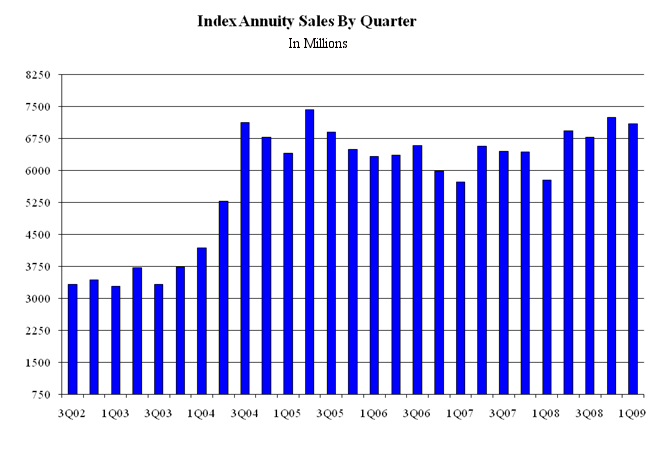
For the first time in the brief history of equity-indexed annuities (EIAs), consumer demand for these controversial structured insurance products is outpacing supply, said Sheryl J. Moore, president and CEO of AnnuitySpecs.com, an insurance product data-gathering firm in Pleasant Hill, Iowa.
Life insurers simply aren’t introducing many new EIAs. Insurers are pressed for capital and waiting for the outcome of the legal battle over who—the SEC or the states—will regulate EIA sales and which industry—securities or insurance—will control sales of this lucrative niche product.
“Carriers are holding back to see what is determined in the 151A case against the SEC. We actually lost 27 products during the first quarter,” Moore told RIJ. Thirteen companies have exited the indexed annuity market since the fourth quarter of 2008, she said.
First quarter EIA sales totaled $7.0 billion, up 22.8% from the same period last year, according to the 47th Advantage Index Sales & Market Report. But sales were down 2.1% compared to the fourth quarter of 2008. Fifty EIA-issuing carriers were surveyed, representing 99% of production.

Source: AnnuitySpecs.com
Aviva was the top EIA seller in the first quarter, with $2.4 billion in sales, followed by Allianz Life, with $1.1 billion, American Equity Investment Life with $630 million, Lincoln National with $368 million, and Midland National with $359 million.
Lincoln rose to fourth place from tenth and Jackson National moved to sixth place from ninth. American Investors Income Select Bonus was the top product for the third consecutive quarter. Nearly 57% of indexed annuity sales come through Iowa-domiciled companies.
“Never has there been a better opportunity to manufacture or sell indexed annuities,” said Moore in a press release. “The demand for indexed annuities has never been greater because of American’s flight to quality from the equities markets.
“Unfortunately, the supply of annuities cannot keep up with the demand right now, because annuities are so capital intensive. This is the first time I have ever seen a mismatch between the supply and demand of these products—it’s a dilemma.”
EIAs are structured products that offer principal protection via a bond component that earns about 3% per year, plus modest exposure to equity market returns through the purchase of equity derivatives.
Indexed annuities, as they are also called, tend to thrive when investors are too risk-averse for equities but unwilling to buy bonds because of unattractive yields. EIA return calculations are complex and vary from contract to contract, but the products have historically delivered what they promise: downside protection and upside potential.
Only two new EIA contracts were issued in the first quarter of 2009: Forethought Life’s single-premium Income 125 annuity (25% bonus on income base) and American Equity’s Retirement Gold annuity (12% or 6% premium bonus, depending on age). Both products have mandatory guaranteed lifetime withdrawal benefits (GLWB).
Forethought’s Income 125 has a minimum initial premium of $25,000 and a 10-year surrender period with a first year charge of 12%. The 25% bonus is broken into five percent annual increases to the benefit base over ten years. It applies only to the guaranteed income base, not to the account value. The owner receives the bonus in the form of an enhanced annual payout, and only if he or she exercises the lifetime income option.
The product has four income options: a 5% annual payout for life, a 4% payout with a 2% inflation adjustment, a 4%payout with spousal continuation, and a 3% payout with a 2% inflation adjustment and spousal continuation. After income begins, the income base automatically steps up to the account value, if greater, once a year.
Income 125 offers a choice of three crediting methods: annual point-to-point, monthly average, and monthly point-to-point, all with 100% participation in S&P 500 Index gains up to 5.25% annually, 6.25% annually, and 2.25% monthly, respectively. The commission is 8.5% for purchasers to age 75.
American Equity’s Retirement Gold product, a flexible-premium EIA with a $5,000 minimum initial premium, has a GLWB with four age-band payouts: 4% annually for those ages 50-59, 5% for those ages 60-69, 6% for those ages 70-79 and 7% for those over age 80. The payout for spousal continuation is one percent less in each age band.
Retirement Gold offers five annual crediting options, all pegged to the S&P 500. There are two annual point-to-point options, one with a 100% participation in equity gains up to 6.5%, and one with 25% participation and no cap on gains. There are two monthly averaging options, and one monthly point-to-point with 100% participation up to 2.6% per month. The producer commission is 8% for purchasers to age 78.
Both products, with their initial surrender charges over 10%, appear to violate the so-called “10/10 rule” that many securities broker-dealers have adopted in recent years. Those broker-dealers have declared that, if they begin supervising EIA sales, they won’t sell any EIA contract with a surrender charge over 10% or a surrender period over 10 years.
Moore said both products were technically within the 10/10 rule. “The bonus on the Forethought product is credited to the GLWB benefit base, so it does not count as far as state [regulators] are concerned,” she said. “The AEIL product has a net effective first-year surrender charge of 0.5% [because of its 12% premium bonus]. So, it passes.”
© 2009 RIJ Publishing. All rights reserved.



